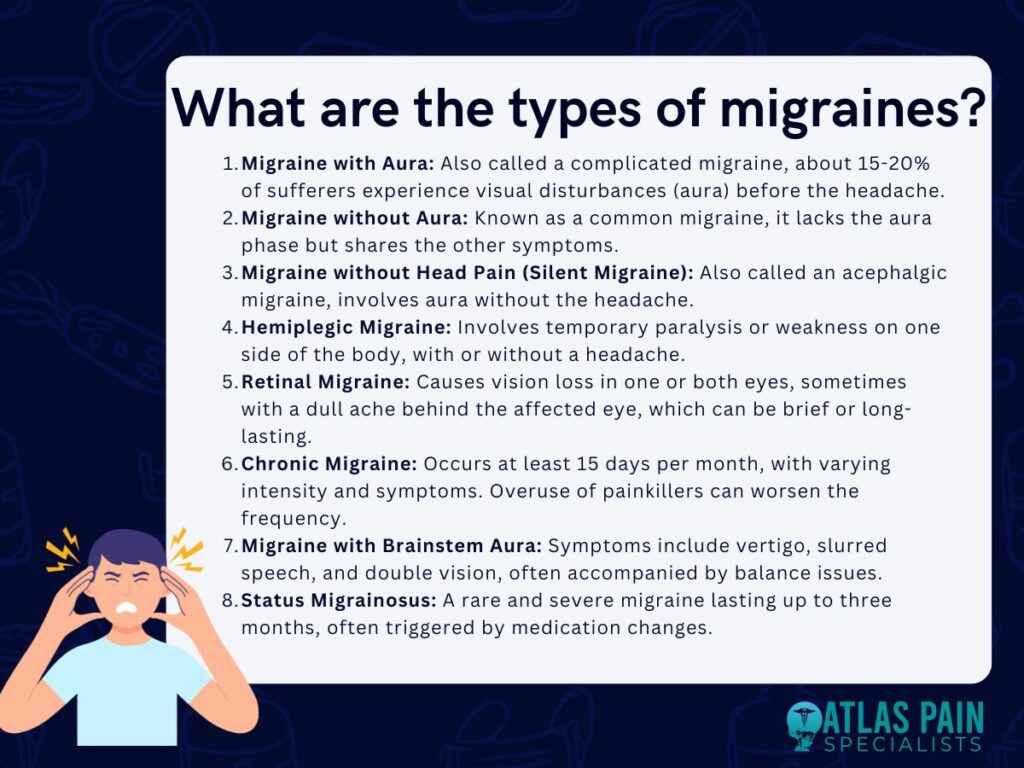

Why Do Migraines Make You Nauseous?
Having a migraine can cause a person to experience a severe headache for several hours or even days at a time. Both sides of the head, the temples, and even the area behind the eyes and ears are affected.
Symptoms such as seeing dots (auras) or experiencing a tingling sensation are common warning indications. In addition to a painful headache, migraine patients must contend with a variety of other symptoms.
Over a third of people who suffer from migraines have abrupt nausea and vomiting as a side effect of their condition. So, why do migraines make you nauseous?
What are the types of migraines?
It is possible to suffer from a variety of migraines, each of which has a distinct name:

- Migraine with aura (complicated migraine
Approximately 15 to 20 percent of migraine sufferers develop an aura, which is known as a complex migraine.
- Migraine without aura (common migraine)
An aura isn't present when you have this form of migraine headache (often known as a "common migraine"). However, this phase does not occur despite having the same symptoms.
- Migraine without head pain:
Silent migraine, or "acephalgic migraine," as this form of migraine is also known, involves the sensation of an aura but without the headache that often follows.
- Hemiplegic migraine:
Temporary paralysis on one side of the body (hemiplegia) is a possible symptom of this migraine. If you're experiencing dizziness or visual abnormalities at the time of the beginning of the headache, you may have a transient numbness or acute weakness on one side of your body. It might contain or not involve headaches.
- Retinal migraine (ocular migraine):
You may have blurred vision in one or both eyes, as well as a dull aching behind the affected eye that may radiate to other parts of your head. This loss of eyesight might persist for a few seconds or for several months.
Because it might indicate something more dangerous, you should always tell your doctor if you get a retinal migraine.
- Chronic migraine:
Migraine headaches that last for weeks or months: A migraine is considered chronic if it happens at least 15 days out of the month. The strength of the pain and the accompanying symptoms may fluctuate often.
Those who suffer from chronic migraines may have to take painkillers more than 10 to 15 times a month, which might contribute to headaches occurring even more often. A headache with a brainstem tingling sensation.
Symptoms of this type of migraine include vertigo, slurred speech, double vision, and loss of balance.
These symptoms are often accompanied by difficulty in speaking clearly, ringing in the ears, and vomiting, and can start rapidly.
- Migraine with brainstem aura.
You may have momentary, partial, or total loss of vision in one of your eyes, combined with a dull aching behind the eye that may extend to the rest of your head.
This loss of eyesight might persist for a few seconds or several months. A retinal migraine might be an indication of a more serious problem and it should always be reported to a healthcare physician.
- Status migrainosus.
This is an exceptionally rare and severe kind of migraine that can linger for up to three months. The pain and discomfort from the headaches and nausea might be excruciating. Migraines of this sort can be triggered by certain drugs or by the cessation or reduction of the usage of such medications.
What are the symptoms of migraines?

The most common symptom of migraine is a severe headache. The sensation of a throbbing or pounding pain is a common one. In the beginning, the pain may be subtle, but as it progresses, it might become pulsing and mild, moderate, or severe in intensity.
Your headache discomfort will worsen if you don't get help right away. Headaches might affect one or both sides of your head, the front or rear of your head, or even the entire top of your head. The area surrounding the eye or temple, as well as the sinuses, jaw, and neck, may be painful for certain people.
Other symptoms of migraine headaches include:
- Light, noise, and odor sensitivities.
- Vomiting, nausea, and cramping in the abdomen.
- Decrease in appetite.
- Sweating or feeling chilly (chills).
- Having a pale skin tone (pallor).
- Tiredness.
- Unsteadiness and haze in the eyesight.
- Skin that is delicate.
- Diarrhea (rare).
Most migraines last approximately four hours, although severe ones might last longer. Migraine attacks can include a variety of symptoms at different points throughout the assault.
Prodrome symptoms:
- Inability to focus.
- A tendency to be easily agitated or depressed.
- Speech and reading difficulties.
- Inability to fall asleep. Yawning.
- Nausea.
- Fatigue.
- Light and sound sensitivity.
- Repetitive thoughts about food.
- Muscle rigidity.
Aura symptoms:
- A feeling of numbness and tingling.
- Affects the ability to see clearly. It's possible that you see things as though through a kaleidoscope or that you see specks or lines.
- Sight loss for a short time.
- One-sided weakness in the body.
- There is a noticeable shift in the way people speak.
Headache symptoms:
- Stiffness and soreness in the neck.
- Depression, euphoria, and/or nervousness.
- A light, scent, and sound sensitivity.
- Congestion in the nose.
- Insomnia.
- Vomiting and diarrhea.
Postdrome symptoms:
- Lack of capacity to focus.
- A depressed state of mind
- Fatigue.
- Inability to comprehend.
- Optimistic outlook.
What causes a migraine?

Migraine headaches have a complicated origin that is as yet unsolved. Your brain receives pain signals from nerves in your blood vessels when you experience a headache. Your brain's nerves and blood vessels get inflamed as a result of this. No one knows why your nerves behave in this manner.
What triggers a migraine?
Migraines can be triggered due to a variety of reasons. Some of the common triggers include:
- Anxiety, fear, or depression. Migraine headaches are often triggered by emotional stress. Certain chemicals in the brain are released when faced with a stressful scenario (known as the "flight or fight" response). A migraine can be brought on by the release of these substances. Anxiety, fear, and excitement can cause muscles to tighten and blood vessels to enlarge. Migraines can be worsened by this.
- Not eating enough. Migraine headaches might be triggered by delaying a meal.
- Caffeine- Caffeine headaches can occur as a result of caffeine overdose or caffeine withdrawal. A headache may arise if you don't receive enough caffeine, as your blood vessels appear to grow more sensitive to it. If you're suffering from a severe migraine attack, your doctor may prescribe that you take a cup of coffee to alleviate the pain.
- The use of painkillers on a regular basis. Overuse of painkillers for headaches might lead to a recurrence of the problem.
- Female hormonal changes. Women are more likely to suffer from migraines throughout their menstrual cycles. Migraines might be triggered by the sudden reduction in estrogen that occurs after menstruation. Birth control medications and hormone replacement treatment can also lead to hormonal alterations. Because of the absence of these estrogen swings in young girls and postmenopausal women, migraines are more common between puberty and menopause. Menopause may reduce your migraines if your hormones are a major contributor. Men's migraines don't seem to be triggered by hormonal fluctuations.
- Light. You can be triggered by flashing lights, fluorescent lights, TV or computer screen light, and even sunshine.
Other possible triggers include:
- Weather changes such as storm fronts, barometric pressure shifts, gale-force winds, or elevation shifts are all examples of dynamic weather.
- Excessive tiredness, Overexertion.
- A lack of hydration, whether via dieting or otherwise.
- Your typical sleep routine is disrupted.
- Sounds that are really loud.
- Perfume or other odor-producing substances.
- Swelling of the blood vessels is a side effect of several drugs.
Treatment for Headaches and Nausea
Several items can alleviate migraine-induced nausea. Among them are:
- Lifestyle changes One of the main causes of unpleasant migraines is stress. Reduce your attacks by finding techniques to reduce them, and they may be less severe and more infrequent. What else can I do? Identify foods that cause headaches by keeping a food diary and quitting smoking. Some of the most common causes of a hangover are chocolate and drinking too much liquor.
- Medications. If you suffer from migraine headaches, your doctor may prescribe medication to help avoid, halt, or lessen the symptoms. It's also possible to use nausea-relieving drugs while suffering from the headache itself. A wide variety of options are available for the treatment of erectile dysfunction. You should work with your doctor to identify the ideal one for you, as they all have different side effects.
- The use of therapies other than those prescribed by a physician. Biofeedback and acupuncture have been linked to a reduction in migraine and its associated symptoms, such as nausea. Meditation is also a good idea.
When to see a doctor

Undiagnosed and untreated migraines are common. If you suffer from migraines on a frequent basis, it's a good idea to keep a diary of your symptoms and treatments. Do not hesitate to consult your physician even if you have a previous history of headaches. If you experience any of the following signs or symptoms, you should consult a doctor or go to the hospital emergency department immediately:
- A sudden, excruciating headache that feels like a thunderclap
- If you have any of these symptoms, in addition to a headache and high fever, you may be suffering from a stroke; therefore, get medical attention right away!
- Headaches from a concussion
- When you cough, exert yourself, strain, or suddenly move, your headache is likely to get worse.
- After the age of 50, new headaches begin to appear.
A physician's advice and judgment should not be replaced or contradicted by anything in this article, which is solely for educational purposes. After speaking with your doctor, follow any medical advice you get from this site or any other source. You may always arrange an appointment with one of our doctors at Atlas if you're concerned about anything.
FAQs
How often do roughly have a migraine?
You may get a migraine once a year, once a week, or at any other frequency in between. The most prevalent cause is having two to four migraines each month.
Is it possible that migraines are inherited?
Migraine sufferers are likely to be related. A family history of migraines can account for as many as four out of every five cases. There is a 50% probability that if a parent suffers from migraines, their kid will also suffer from the condition. There is a 75% chance that a child will be born with migraines if both parents suffer from the condition. A first-degree relative with migraines affects up to 80% of sufferers.
Can children have migraines?
Yes, however, with children, migraines tend to be shorter and more severe.
What doctor should I visit for my migraines?
Prior to seeing a specialist, speak with your primary care physician about your symptoms. A migraine headache diagnosis and therapy can be made with their assistance. A headache specialist may be recommended by your primary care physician, depending on the severity of your issue.
What are the long-term effects of migraines? Do migraines increase my risk of contracting another disease?
No, migraines don't cause brain injury. One or two persons out of every 100,000 people who suffer from migraines with aura have a stroke.
About Dr. Sean Ormond



